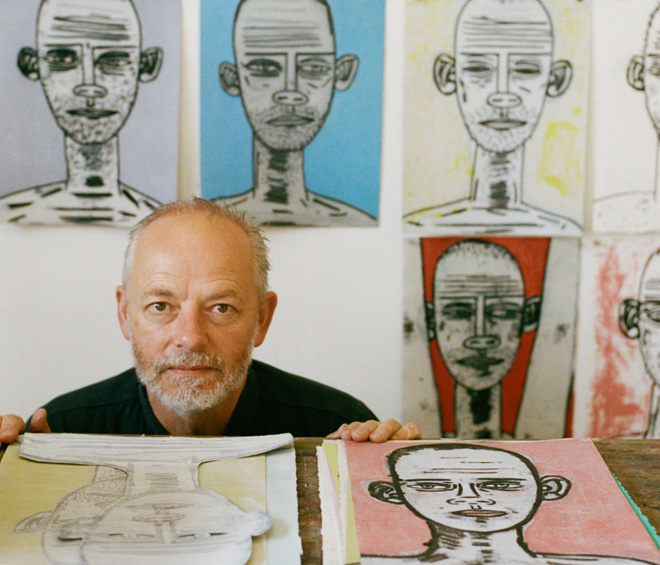
David Austen in his studio. Photo: Ben Stockley.
by CHRISTIANA SPENS
Working across painting, sculpture, printmaking and film, British artist David Austen (b1960, Harlow) creates worlds within galleries, constructing the unreachable and impossible in a stylised, approachable, yet disarming manner. In Underworld, his new exhibition at Dundee Contemporary Arts, visitors are invited to explore a house within the gallery itself. The house contains fragile watercolours of lost people and is surrounded outside by the stars, the moon, a crystal city and two mesmerising trees.
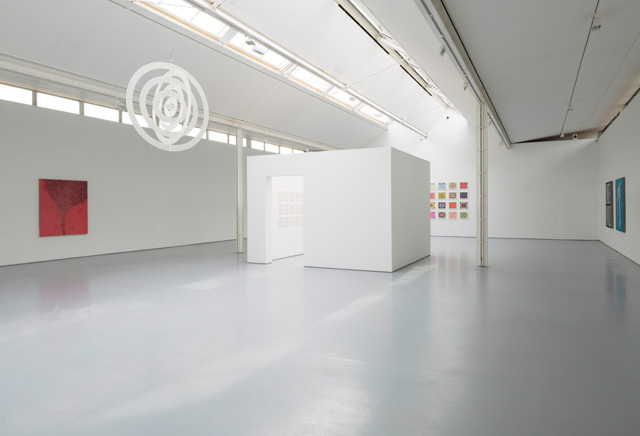
David Austen: Underworld, installation view, Dundee Contemporary Arts, 2019. Photo: Ruth Clark.
In a smaller room, meanwhile, four short films play. The Gorgon’s Dream, which shows the head of a gorgon, held by a man’s arm, her eyes closed, recalls not only sculptures of Perseus and the Gorgon, but also the highly charged, elegant photography of Lee Miller. In the hypnotic Burn the Witch on the Stairs, meanwhile, a piece of text is filmed and reversed, seeming to be on fire itself, disintegrating. In The Story of My Death As Told to Me By Another (2015), Austen, dressed as a melancholic clown, speaks of the violent death his friend dreamed he had suffered. Imbued with mythological references and with the charming, yet anxious atmosphere of old silent films, the exhibition creates a stirring retreat from the world, in which its mysteries seem smaller, within reach, and yet worryingly unknown still. The little place created here, it becomes apparent, is a limbo between worlds, a verge to peer off, anxiously.
I spoke to Austen before the opening of the show, where he showed me around the exhibition and talked about his influences and ideas.
Christiana Spens: I’d like to to ask you about escapism.
David Austen: What do you mean by escapism?
CS: In this context, I mean a world constructed from shared associations and imaginary worlds. Your installations remind me of old silent films, with their sense of style and suspension.
DA: I’m very fond of making art that is almost theatrical. It’s also about the slapstick humour and the way you can’t hear what people are saying, in those films. Normally, if you say something is theatrical, that’s a bit disparaging – but I like it. I like those films where they create a world in which everything has a place. That’s very much how I approach it.

David Austen. The story of my death as told to me by another, 2018. 16mm film. Courtesy the artist and Ingleby Gallery.
CS: So you do that in reaction to dissatisfaction with the real world?
DA: Oh, it’s out of the real world, though: everything here is real.
CS: But it’s mediated and changed and constructed into something more manageable? Or maybe you can find more meaning in something that has been turned into something else, even if it’s rooted in the present?
DA: It’s just curiosity, I think. I read an awful lot – literature and poetry and plays – and I’m just fascinated by people putting these things together, the act of it.
CS: So, it is more explorative?
DA: Yes, and also as you say, people who can convincingly describe a world, whether that’s Tennessee Williams or Flannery O’Connor. You read O’Connor’s writing and it’s almost like everything feels real. So it’s not like it’s not real life. It’s a version of it.

David Austen. The light that fell upon us burned, 2016. Gouache on paper, cut and pasted (32 parts). Courtesy the artist and Ingleby Gallery.
CS: But it’s like a magic trick as well, do you think?
DA: Well, sometimes you have to stylise things in order to make them more real than real, if you like.
CS: You mentioned Tennessee Williams, and I love his work, and you know when you read the stage directions, and everything is imbued with this style.
DA: Yes, that’s probably why he came to mind, actually. The way people talk, too, and the way – I wouldn’t say magical, exactly, but strange things happen, don’t they?
CS: Absolutely. I think it’s the New Orleans setting as well.
DA: Which gives it an otherworldly feel. And also the characters – I suppose you’d say they were larger than life.
CS: And preoccupied with illusion and so on.
DA: Yeah, and, like Orpheus Descending, a lot of them have parallels with mythology, don’t they?
CS: Yes, like Elysian Fields in A Streetcar Named Desire.
DA: Yes, exactly, and also if you think of the last few times they’ve been put on in London, they’ve been incredibly stylised. The last show of Streetcar involved a glass set, for instance.
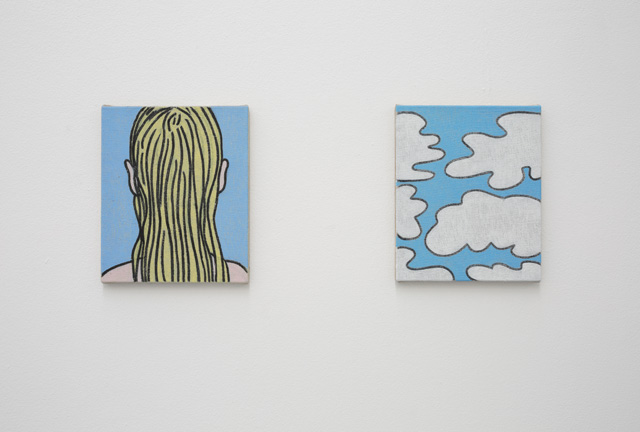
David Austen: Underworld, installation view, Dundee Contemporary Arts, 2019. Photo: Ruth Clark.
CS: Yes, he seems to spend a lot more time on the stage directions than a lot of playwrights do; it’s very visual. In terms of this show, can you tell me a bit more about the specific influences? I keep looking at these tree-like shapes over here … They also remind me of a stage set, in a way.
DA: I’m not sure what the influences are with the trees. I’ve always done trees, though. I’ve painted about one tree a year. But they’re not like real trees, even though they obviously have a lot of observation of real trees in them.
CS: They remind me of Celtic patterns a bit, the way the branches interweave.
DA: Catholic?
CS: Celtic.
DA: I thought you said Catholic, and it reminded me that I really like the whole medieval period of art, you know the way everything’s very stylised.
CS: And often engraved or carved.
DA: Exactly, very graphic, very flat. I find that more real than say, art 200 years later. You could also say, maybe there’s a Japanese influence, too.
CS: You know it reminds me of the hair in the film you have showing, The Gorgon’s Dream; it reminds me of that motion, the hand holding the head by the hair.
DA: Yes, yes. That one’s called Medusa Tree, actually.
CS: That makes sense, then.
DA: Yes, so that relates to the film as well. The other one’s called Flame Tree. And they’re brand new. The first time I came to see the space, I was talking to [DCA’s Director] Beth Bate about how it’s such a big space, and how can we do things that are quite intimate – the watercolours and drawings – and also show the big things that are more cinematic, if you like. So, I thought, we should build a house. It’s really simple, actually. First of all, I thought, we’ll build a house to put the watercolours in, but then I want a window, so it becomes like a real house, not a gallery in a gallery. I thought, if you put a window in, then it becomes a house. And then as soon as I drew it out, I immediately thought it would be nice to have a tree on either side. And then I showed it to someone and they said: “Oh, you’re making a garden around your house.” It hadn’t occurred to me at all, but, of course, that’s exactly what I started to do, because I even put the moon up, and the stars. It became strangely like the world we were talking about, with these strange trees that look incredibly animate, but also very still. They’re trees, but they’re also very much about drawing a tree. They’re quite animalistic, almost: you can see snakes and they’re quite sinister.
CS: I used to have recurrent nightmares, as a child, that I was being smothered by trees. There’s something very mystical and otherworldly about them.
DA: Yes, and maybe it makes you think about Diana as well. Does she turn into a tree? Someone turns into a tree. After being chased, Actaeon – no, that’s when she turns him into a stag. She fired the arrows at him.
CS: Oh, and arrows as well; they look like arrows, and antlers.
DA: Yes, they have that. They look almost like limbs, too.
CS: Can you tell me a bit about this series of paintings, Crystal City?
DA: Yes. I often do a series of gouaches and I suppose you’d regard them as abstract. The strange thing is that the abstract pieces begin from something I’ve seen – I make notes and drawings. So the things that are abstract are often from something observed, in the real world, and the things that look real, I just made up. There’s a painting over there called Glass, and it’s a recurring thing. I’ve used glass structures as if they’re glass buildings.

David Austen. Glass, 2015. Oil on flax canvas. Courtesy the artist and Ingleby Gallery.
CS: They look a bit like stained-glass windows.
DA: They do, but when you get up close, the shapes are painted as close as they can get to another shape, so the line that you see between them, that’s the paper, that’s what’s left, so they’re not all drawn out. I paint one shape, and it’s about the relationship between one and the one next to it. It’s also kind of based on a recurring dream I have – like yours really – a bit of a nightmare, where I used to be chased by this lizard, this naked lizard woman, who was green and scaly, and this was like from the age of eight, and going through this glass crystal city, that was falling apart and was all kind of rickety, so they fall back on that. I think I probably dream it, even now, every two years.
CS: Mine used to be a dream, but it’s turned into more like a panic attack or claustrophobia, or something.
DA: Yes, same, a panic thing.
CS: It reminds me of the Tennessee Williams ideas again, as well, of the glass constructs, The Glass Menagerie. I suppose it also makes me think of greenhouses and conservatories.
DA: And throwing stones. They’re about things that get broken. Fragility.
CS: And transparency, too. Being watched.
DA: Yes.
CS: And so here we have Underworld, too, and a man drowning in blue.
DA: Yes, he feels as if he’s tumbling, around and around and around. I based him on a quick drawing I did in Seville, in the cathedral. There was a deposition of Christ, and Christ was sort of folded over, and there was a real sense of dead weight.
CS: I was going to say that it reminded me of those pictures that came out after 9/11, of people falling out of the Twin Towers.
DA: Yes. Well, he looks an awful lot like my dad, actually, who died a couple of years ago. And these scars, because he had been cut all the way down, in surgery. And it was painted before that, actually. But you get the feeling of tumbling around and around.
CS: In a sort of doomed limbo.
DA: Yes, exactly.
CS: So there is a religious aspect, a Catholic motif, together with the Underworld and Orpheus.
DA: Yes, we were going to put some other photographs up, which we didn’t in the end, and one of them is … I like collecting, they’re like pin-up photographs from the US from the 1940s and 50s. They’re usually pocket-sized. But the ones I like are of backs of women, and then, when you get a lot of them, it’s like there’s all these backs, and they’re really quite strange, and it reminds me of Orpheus, you know, even though, of course, Eurydice is behind him, there’s something of her in these photographs. They’re very strange and eerie when you see a lot of them.
CS: I was thinking as well of an audience. If you’re creating a theatrical thing, then the idea of having an audience who all have their backs to you is kind of funny.
DA: Exactly.
CS: I’d like to ask you about the reference to a quote in Albert Camus’ The Plague (La Peste), which you use in the screenprint of the same title, It Began in a Happy City.
DA: It is drawn from the very last paragraph of the novel. The plague has finished, it’s retreated, the town’s sort of getting back to normal. But there’s a little author note, that last paragraph, and he says something like: “The plague is disappearing but it lies dormant. Little did the population know that the bacteria cells in the rats lie dormant.” And then he goes into a description of it being in linen-chests and on bookshelves, all those little places, and how rats could be roused again and “sent to die in a happy city”. It could happen again. So what I’ve done is almost create a sequel, and the first line is: “It began in a happy city.” And, of course, what Camus is really writing about is fascism.
CS: Yes, that seems quite prescient for current times.
DA: Yes, that’s what he’s saying; fascism lies between the floorboards. As we now know.
CS: I was just thinking, that idea of it being stored in the linen-chests and so on. These paintings contain all this wildness and mythology and underworld, and yet, when you come in, it seems very contained, and I wondered if it’s that sense of tension, that it is lying in wait, to take you. In the way that in Orpheus, obviously, there is also that tension.
DA: Yes, I think I know what you mean. In all the works, there’s a tension. The reason they’re painted with small brushes and things – you know, these backgrounds take weeks to paint – is because I like to embed time.
CS: There’s almost another world out there, and it’s sucked into an image
DA: Yes, I want to have a density, of real life, contained there.
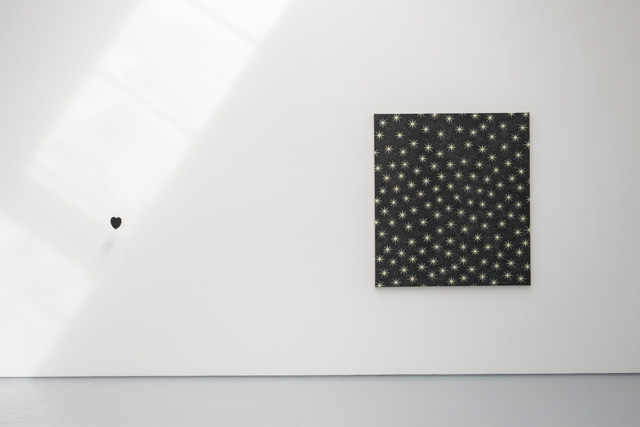
David Austen: Underworld, installation view, Dundee Contemporary Arts, 2019. Photo: Ruth Clark.
CS: In this painting, for instance, all the stars are contained in one frame, like a window looking out to the sky. And in other work you have used moons and stars and planets. They remind me of children’s books such as Le Petit Prince, and baby mobiles as well, and I wondered if those influences were intentional?
DA: Oh, probably. I really like Antoine de Saint-Exupéry’s novels as well, and his diary, Wind, Sand and Stars. He must have been a crappy pilot, though, because he’s constantly crashing, and then he eventually disappears. There’s a wonderful story where he lands on a raised plateau, where everything has been eroded but just this surface has been left. He lands on one of those one day, crash lands, and he gets out and realises that the surface is made of seashells, so what’s now right up here would have once been the bed of an ocean, simply because the softer ground had been eroded. And what’s great about it is, he’s not thinking: “Let’s fix the aeroplane and get on with this thing.” He starts walking around and he realises no one’s ever been up there because it’s too far up, too hard even for a goat to climb. So, he’s walking around on these crushed seashells, and he sees this object and picks it up, and then he sees another one about 40 yards away and goes, “ooh!” and they’re meteorites. He realises that because this surface has been there for hundreds and hundreds of thousands of years, it’s not that it’s got more meteorites than anywhere else on the planet, it’s just that no one’s ever moved them. So if the world hadn’t been touched by anyone, that’s what it would look like. And so it’s such an amazing story.
CS: There’s such a sense of wonder.
DA: Yes, a sense of wonder. And I’m just as influenced by Dr Seuss, in my work.
CS: Oh, yes, of course.
DA: It’s kind of obvious, really. And Gustave Doré – there are lots of illustrators’ influences. I think Dr Seuss is as great as Picasso.
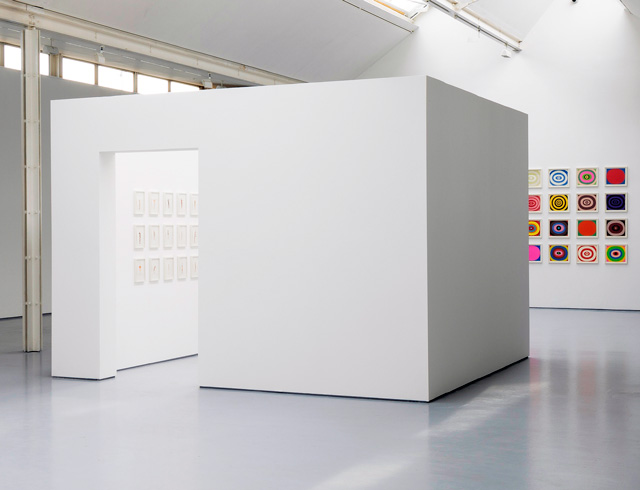
David Austen: Underworld, installation view, Dundee Contemporary Arts, 2019. Photo: Ruth Clark.
CS: On that note, maybe we should talk briefly about Room for the Drowned.
DA: Yes, so that’s just the room (itself). And then the work is called The Drowned. I’ve done lots of other series of watercolours of figures; it’s something I’ve done ever since I became an artist, really. And all of the work, really, is about the materials. So this is what oil paint does, this is what gouache does, this is what watercolour does, in this case.
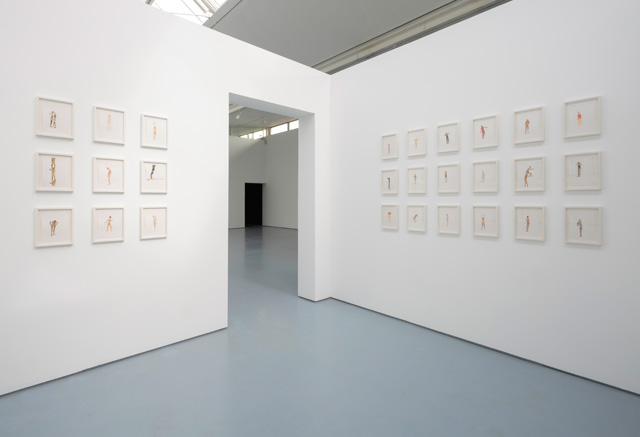
David Austen: Underworld, installation view, Dundee Contemporary Arts, 2019. Photo: Ruth Clark.
CS: It’s creating a world out of art materials, literally. As elements.
DA: Yes. They have a different weight to them.
CS: So the people, then, are the most ephemeral of all of the materials?
DA: Yes, they’re like a shipwrecked group of people.
CS: Having them in the house, it’s almost as if they are in a quarantine, thinking back to The Plague. Or an asylum.
DA: Yes. They’re quite self-absorbed, though. They don’t look as if they particularly mind being in boxes on their own.
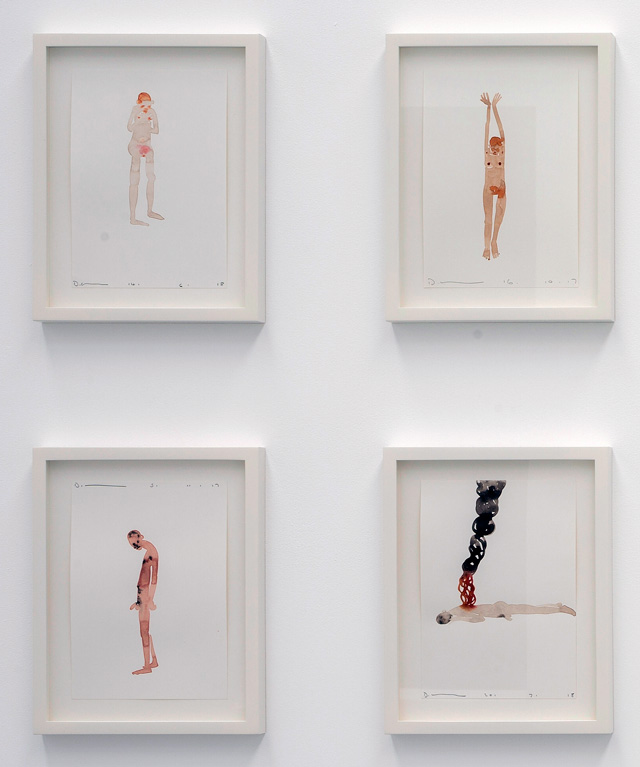
David Austen: Underworld, installation view, Dundee Contemporary Arts, 2019. Photo: Ruth Clark.
CS: They are not really grounded at all, but floating – the only hope of connection or gravity seeming to be with each other, even though the other figures are usually in other boxes.
DA: Well, I disagree with the floating bit, because, for me, they succeed. It’s the lightest medium in the world, watercolour, but they succeed for me when they feel as if they have gravity, when they look like they have weight.
CS: Maybe humans don’t need much gravity?
DA: Yes, it’s difficult, but that idea of gravity goes through all the work. I’ve always loved that Egyptian idea of weighing the souls, and the balance between gravity and weight.
CS: The bodies and planets are similar sizes and significances to one another – you know, the tree and the moon are the same size – as if people and plants and stars are always suspended a little from each other, seeming close but light years away.
DA: Yes, that’s a nice way to put it. Did you say planets or plants?
CS: I meant ‘planets’.
DA: They do have a plant-like quality to them, though.
CS: Like plants in a greenhouse
DA: Yes, or there’s a quality of pressed flowers, as well.
CS: Yes, very fragile.
DA: There’s a drawing in the back room as well, which I did when I was about 25, called Exit – which is by the fire exit – of a man opening his coat, and all these creatures are falling out.
CS: There is definitely a sense of being slightly on the verge of falling into another world.
DA: Yes. Not quite remembering where you are.
CS: Is the idea that you find peace with that?
DA: No. It’s about anxiousness. I don’t think any of my work would bring peace to anybody. I think they’re all about the trembling of anxiety.
CS: I find the trees quite calming, though.
DA: Sometimes I find the gouaches calming, in a way, afterwards. But they’re a real pain in the arse to make. I don’t make any of the works in a calm state. They’re methodical, but they’re very intense. And any mistake, that’s it. Messed up.
CS: Is that not cathartic, though? Or maybe it’s a record of that state. You embed the work with angst.
DA: I don’t know. Do you think a poet, when he writes a poem, finds it cathartic? I don’t think Tennessee Williams would have found writing cathartic, but maybe he did. But even then, it doesn’t last very long, catharsis.
CS: Maybe with stage plays, and perhaps all art, you are sacrificing your own sanity to some extent, but you know you are giving some sense of catharsis or solidarity to other people through that. So it is like a gift.
DA: Yes, I like that idea that it’s a gift, for the 400 people seeing a play, or whatever it is. It’s quite an incredible thing, that.
• David Austen: Underworld is at Dundee Contemporary Arts, Dundee, until 9 June 2019.